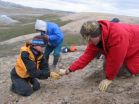(Press-News.org) DURHAM, N.C. -- While inadequate funding has hampered international efforts to conserve biodiversity in tropical forests, a new Duke University-led study finds that people in a growing number of tropical countries may be willing to shoulder more of the costs on their own.
"In wealthier developing countries, there has been a significant increase in public demand for conservation, which has not yet been matched by an equivalent increase in protective actions by the governments of those countries," said Jeffrey R. Vincent, a Duke environmental economist who led the study, which appears this week in the Proceedings of the National Academy of Sciences.
Nearly half of the world's threatened endemic tropical mammal, bird and plant species are found in 27 developing counties that the World Bank now classifies as having reached upper middle income (UMI) status.
UMI countries, which include Brazil, Costa Rica, Mexico, Gabon, Malaysia, Peru and Thailand, also contain nearly 80 percent of the world's primary tropical forests, which play a major role in carbon storage.
"Our research suggests that as incomes rise in these countries, it creates a new opportunity for domestic funding to play a larger role in supporting efforts to protect forests and forest species from logging, poaching and other threats," Vincent said. "This could make a big difference in protecting tropical biodiversity and reducing greenhouse gas emissions from deforestation and forest degradation."
To measure how these countries' rising household incomes have affected public demand for biodiversity conservation and their governments' expenditures on it, Vincent and a team of international scientists analyzed economic indicators from high income, upper- and lower-middle-income, and low-income tropical countries.
Among other indicators, they tracked per capita donations to nongovernmental conservation groups; percentage of land set aside in protected areas; percentage of conservation projects receiving international funding; and results from public opinion surveys about the priority governments should place on environmental protection in relation to potentially opposing concerns such as job creation.
"We found strong evidence that as countries reach upper-middle-income status, support for conservation and willingness to pay for it grows across every indicator we examined, while protective government policies and expenditures lag behind," Vincent said.
To test these findings, the researchers conducted a case study on forest conservation in the remote Belum-Temengor forest of Malaysia's northernmost state, Perak.
As early as 1968, the Malaysian federal government recommended establishing a wildlife reserve in Belum-Temengor to protect its populations of Asian elephants, Malaysian tigers, Sumatran rhinoceroses and other large mammals against poaching and logging. But the Perak state government, which has jurisdiction over the forest, has protected only a third of it. The rest of the forest remains open to logging and, under state law, even the area currently protected could be re-opened for logging, a major revenue source in Perak.
To gauge public demand for expanded protection, Vincent and his team surveyed households in Kuala Lumpur, Malaysia's capital, and the neighboring state of Selangar, and asked how much they would be willing to pay to create a new reserve that would protect all of Belum-Temengor against logging and poaching. The survey defined the benefits of the reserve as reduced extinctions and reduced local flooding, neither of which would directly benefit people living outside Perak. It also detailed the costs associated with creating the reserve, including management costs and the loss of logging jobs.
"Despite receiving no direct benefits, people were willing to pay $6 per month to provide full protection to Belum-Temengor," Vincent said. That works out, cumulatively, to about $437 a year per hectare of land -- a much larger sum than the estimated costs of protecting Belum-Temengor."
"The challenge now," Vincent said, "is translating this growing support into increased government action. One possible solution might be to retool how international funding is allocated. Our findings provide a strong economic rationale for coupling international payments for carbon storage made to UMI tropical countries with biodiversity payments funded by those countries themselves."
Vincent is the Clarence F. Korstian Professor of Forest Economics and Management at Duke's Nicholas School of the Environment and Sanford School of Public Policy.
He conducted the new study with researchers from the University of California (UC) San Diego, UCLA, UC Riverside, UC Berkeley, the University of South Australia, the Forest Research Institute Malaysia, and PE Research. Primary funding came from the Global Environmental Facility through the UN Development Programme, with additional support from Malaysia's Ministry of Natural Resources and Environment and the Forest Research Institute Malaysia.
INFORMATION:
CITATION: "Tropical countries may be willing to pay more to protect their forests," Jeffrey R. Vincent, Richard T. Carson, J.R. DeShazo, Kurt A. Schwabe, Ismariah Ahmad, Siew Kook Chong, Yii Tan Chang, Matthew D. Potts; Proceedings of the National Academy of Sciences Early Edition, June 30-July 4, 2014. DOI:10.1073/pnas.1312246111.
Tropical countries' growing wealth may aid conservation
Rising middle class wants conservation and is willing to pay for it
2014-06-30
ELSE PRESS RELEASES FROM THIS DATE:
Using geometry, researchers coax human embryonic stem cells to organize themselves
2014-06-30
About seven days after conception, something remarkable occurs in the clump of cells that will eventually become a new human being. They start to specialize. They take on characteristics that begin to hint at their ultimate fate as part of the skin, brain, muscle or any of the roughly 200 cell types that exist in people, and they start to form distinct layers.
Although scientists have studied this process in animals, and have tried to coax human embryonic stem cells into taking shape by flooding them with chemical signals, until now the process has not been successfully ...
Research team pursues techniques to improve elusive stem cell therapy
2014-06-30
Stem cell scientists had what first appeared to be an easy win for regenerative medicine when they discovered mesenchymal stem cells several decades ago. These cells, found in the bone marrow, can give rise to bone, fat, and muscle tissue, and have been used in hundreds of clinical trials for tissue repair. Unfortunately, the results of these trials have been underwhelming. One problem is that these stem cells don't stick around in the body long enough to benefit the patient.
But Harvard Stem Cell Institute (HSCI) scientists at Boston Children's Hospital aren't ready ...
Oil palm plantations threaten water quality, Stanford scientists say
2014-06-30
If you've gone grocery shopping lately, you've probably bought palm oil.
Found in thousands of products, from peanut butter and packaged bread to shampoo and shaving cream, palm oil is a booming multibillion-dollar industry. While it isn't always clearly labeled in supermarket staples, the unintended consequences of producing this ubiquitous ingredient have been widely publicized.
The clearing of tropical forests to plant oil palm trees releases massive amounts of carbon dioxide, a greenhouse gas fueling climate change. Converting diverse forest ecosystems to these ...
New study: Ancient Arctic sharks tolerated brackish water 50 million years ago
2014-06-30
Sharks were a tolerant bunch some 50 million years ago, cruising an Arctic Ocean that contained about the same percentage of freshwater as Louisiana's Lake Ponchatrain does today, says a new study involving the University of Colorado Boulder and the University of Chicago.
The study indicates the Eocene Arctic sand tiger shark, a member of the lamniform group of sharks that includes today's great white, thresher and mako sharks, was thriving in the brackish water of the western Arctic Ocean back then. In contrast, modern sand tiger sharks living today in the Atlantic Ocean ...
First pediatric autism study conducted entirely online
2014-06-30
UC San Francisco researchers have completed the first Internet-based clinical trial for children with autism, establishing it as a viable and cost effective method of conducting high-quality and rapid clinical trials in this population.
In their study, published in the June 2014 issue of the Journal of the American Academy of Child and Adolescent Psychiatry, the researchers looked at whether an Internet-based trial was a feasible way to evaluate whether omega-3 fatty acids helped reduce hyperactivity in children with autism. The authors found that not only was it a valuable ...
Research proves shock wave from explosives causes significant eye damage
2014-06-30
Researchers at The University of Texas at San Antonio (UTSA) are discovering that the current protective eyewear used by our U.S. armed forces might not be adequate to protect soldiers exposed to explosive blasts.
According to a recent study, ocular injuries now account for 13 percent of all battlefield injuries and are the fourth most common military deployment-related injury.
With the support of the U.S. Department of Defense, UTSA biomedical engineering assistant professor Matthew Reilly and distinguished senior lecture in geological sciences Walter Gray have been ...
Earth-Kind roses analyzed for salt tolerance
2014-06-30
COLLEGE STATION, TX – Earth-Kind® roses are favorites with gardeners and landscapers. Chosen for their superior tolerance to heat, drought, and pests, as well as their outstanding performance in landscapes, Earth-Kind® roses can thrive in most environments, even with limited care. A new study focused on determining the best Earth-Kind® varieties for withstanding the challenges of salt stress.
As alternative water sources such as reclaimed water are becoming more commonly used as irrigation for urban landscapes and agricultural crops, plants are being subjected to higher ...
New method to grow zebrafish embryonic stem cells can regenerate whole fish
2014-06-30
New Rochelle, NY, June 30, 2014—Zebrafish, a model organism that plays an important role in biological research and the discovery and development of new drugs and cell-based therapies, can form embryonic stem cells (ESCs). For the first time, researchers report the ability to maintain zebrafish-derived ESCs for more than 2 years without the need to grow them on a feeder cell layer, in a study published in Zebrafish, a peer-reviewed journal from Mary Ann Liebert, Inc., publishers. The article is available free on the Zebrafish website.
Ho Sing Yee and coauthors from the ...
With climate change, heat more than natural disasters will drive people away
2014-06-30
Although scenes of people fleeing from dramatic displays of Mother Nature's power dominate the news, gradual increases in an area's overall temperature — and to a lesser extent precipitation — actually lead more often to permanent population shifts, according to Princeton University research.
The researchers examined 15 years of migration data for more than 7,000 families in Indonesia and found that increases in temperature and, to a lesser extent, rainfall influenced a family's decision to permanently migrate to another of the country's provinces. They report in the ...
Study of animal urination could lead to better-engineered products
2014-06-30
Sir Isaac Newton probably wasn't thinking about how animals urinate when he was developing his laws of gravity. But they are connected – by the urethra, to be specific.
A new Georgia Institute of Technology study investigated how quickly 32 animals urinate. It turns out that it's all about the same. Even though an elephant's bladder is 3,600 times larger than a cat's (18 liters vs. 5 milliliters), both animals relieve themselves in about 20 seconds. In fact, all animals that weigh more than 3 kilograms (6.6 pounds) urinate in that same time span.
"It's possible because ...
LAST 30 PRESS RELEASES:
The impact of family dynamics on eating behaviour – how going home for Christmas can change how you eat
Tracing the quick synthesis of an industrially important catalyst
New software sheds light on cancer’s hidden genetic networks
UT Health San Antonio awarded $3 million in CPRIT grants to bolster cancer research and prevention efforts in South Texas
Third symposium spotlights global challenge of new contaminants in China’s fight against pollution
From straw to soil harmony: International team reveals how biochar supercharges carbon-smart farming
Myeloma: How AI is redrawing the map of cancer care
Manhattan E. Charurat, Ph.D., MHS invested as the Homer and Martha Gudelsky Distinguished Professor in Medicine at the University of Maryland School of Medicine
Insilico Medicine’s Pharma.AI Q4 Winter Launch Recap: Revolutionizing drug discovery with cutting-edge AI innovations, accelerating the path to pharmaceutical superintelligence
Nanoplastics have diet-dependent impacts on digestive system health
Brain neuron death occurs throughout life and increases with age, a natural human protein drug may halt neuron death in Alzheimer’s disease
SPIE and CLP announce the recipients of the 2025 Advanced Photonics Young Innovator Award
Lessons from the Caldor Fire’s Christmas Valley ‘Miracle’
Ant societies rose by trading individual protection for collective power
Research reveals how ancient viral DNA shapes early embryonic development
A molecular gatekeeper that controls protein synthesis
New ‘cloaking device’ concept to shield sensitive tech from magnetic fields
Researchers show impact of mountain building and climate change on alpine biodiversity
Study models the transition from Neanderthals to modern humans in Europe
University of Phoenix College of Doctoral Studies releases white paper on AI-driven skilling to reduce burnout and restore worker autonomy
AIs fail at the game of visual “telephone”
The levers for a sustainable food system
Potential changes in US homelessness by ending federal support for housing first programs
Vulnerability of large language models to prompt injection when providing medical advice
Researchers develop new system for high-energy-density, long-life, multi-electron transfer bromine-based flow batteries
Ending federal support for housing first programs could increase U.S. homelessness by 5% in one year, new JAMA study finds
New research uncovers molecular ‘safety switch’ shielding cancers from immune attack
Bacteria resisting viral infection can still sink carbon to ocean floor
Younger biological age may increase depression risk in older women during COVID-19
Bharat Innovates 2026 National Basecamp Showcases India’s Most Promising Deep-Tech Ventures
[Press-News.org] Tropical countries' growing wealth may aid conservationRising middle class wants conservation and is willing to pay for it






